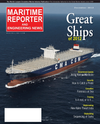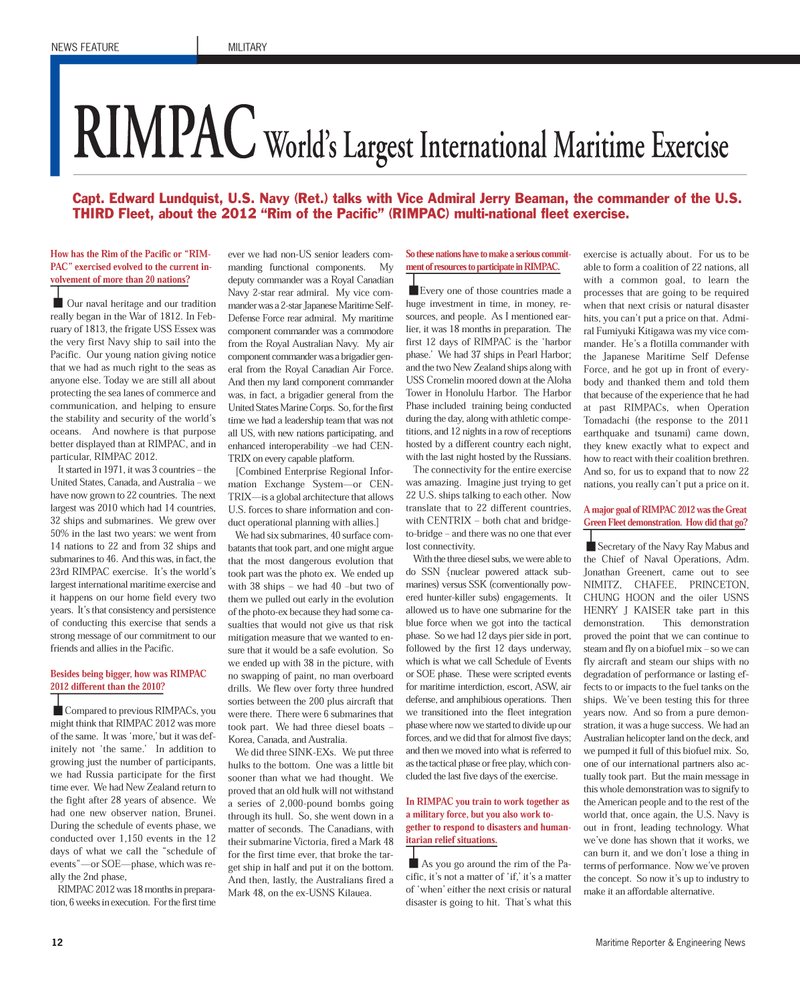
Page 12: of Maritime Reporter Magazine (December 2012)
Great Ships of 2012
Read this page in Pdf, Flash or Html5 edition of December 2012 Maritime Reporter Magazine
12Maritime Reporter & Engineering News How has the Rim of the Pacific or ?RIM- PAC? exercised evolved to the current in- volvement of more than 20 nations? Our naval heritage and our tradition really began in the War of 1812. In Feb- ruary of 1813, the frigate USS Essex was the very first Navy ship to sail into the Pacific. Our young nation giving notice that we had as much right to the seas asanyone else. Today we are still all about protecting the sea lanes of commerce andcommunication, and helping to ensurethe stability and security of the world?s oceans. And nowhere is that purpose better displayed than at RIMPAC, and in particular, RIMPAC 2012. It started in 1971, it was 3 countries ? the United States, Canada, and Australia ? we have now grown to 22 countries. The next largest was 2010 which had 14 countries, 32 ships and submarines. We grew over 50% in the last two years: we went from 14 nations to 22 and from 32 ships andsubmarines to 46. And this was, in fact, the 23rd RIMPAC exercise. It?s the world?s largest international maritime exercise and it happens on our home field every two years. It?s that consistency and persistence of conducting this exercise that sends a strong message of our commitment to ourfriends and allies in the Pacific. Besides being bigger, how was RIMPAC 2012 different than the 2010? Compared to previous RIMPACs, you might think that RIMPAC 2012 was more of the same. It was ?more,? but it was def- initely not ?the same.? In addition to growing just the number of participants, we had Russia participate for the first time ever. We had New Zealand return to the fight after 28 years of absence. We had one new observer nation, Brunei. During the schedule of events phase, we conducted over 1,150 events in the 12 days of what we call the ?schedule ofevents??or SOE?phase, which was re- ally the 2nd phase, RIMPAC 2012 was 18 months in prepara- tion, 6 weeks in execution. For the first time ever we had non-US senior leaders com- manding functional components. Mydeputy commander was a Royal Canadian Navy 2-star rear admiral. My vice com- mander was a 2-star Japanese Maritime Self- Defense Force rear admiral. My maritime component commander was a commodore from the Royal Australian Navy. My air component commander was a brigadier gen- eral from the Royal Canadian Air Force. And then my land component commanderwas, in fact, a brigadier general from the United States Marine Corps. So, for the first time we had a leadership team that was not all US, with new nations participating, and enhanced interoperability ?we had CEN-TRIX on every capable platform. [Combined Enterprise Regional Infor- mation Exchange System?or CEN-TRIX?is a global architecture that allows U.S. forces to share information and con-duct operational planning with allies.]We had six submarines, 40 surface com- batants that took part, and one might argue that the most dangerous evolution that took part was the photo ex. We ended up with 38 ships ? we had 40 ?but two of them we pulled out early in the evolution of the photo-ex because they had some ca- sualties that would not give us that risk mitigation measure that we wanted to en- sure that it would be a safe evolution. So we ended up with 38 in the picture, withno swapping of paint, no man overboard drills. We flew over forty three hundred sorties between the 200 plus aircraft thatwere there. There were 6 submarines that took part. We had three diesel boats ? Korea, Canada, and Australia. We did three SINK-EXs. We put three hulks to the bottom. One was a little bit sooner than what we had thought. We proved that an old hulk will not withstand a series of 2,000-pound bombs goingthrough its hull. So, she went down in a matter of seconds. The Canadians, with their submarine Victoria, fired a Mark 48 for the first time ever, that broke the tar- get ship in half and put it on the bottom.And then, lastly, the Australians fired a Mark 48, on the ex-USNS Kilauea. So these nations have to make a serious commit- ment of resources to participate in RIMPAC. Every one of those countries made a huge investment in time, in money, re- sources, and people. As I mentioned ear- lier, it was 18 months in preparation. The first 12 days of RIMPAC is the ?harbor phase.? We had 37 ships in Pearl Harbor; and the two New Zealand ships along with USS Cromelin moored down at the Aloha Tower in Honolulu Harbor. The Harbor Phase included training being conductedduring the day, along with athletic compe- titions, and 12 nights in a row of receptions hosted by a different country each night, with the last night hosted by the Russians.The connectivity for the entire exercise was amazing. Imagine just trying to get 22 U.S. ships talking to each other. Now translate that to 22 different countries, with CENTRIX ? both chat and bridge-to-bridge ? and there was no one that ever lost connectivity. With the three diesel subs, we were able to do SSN {nuclear powered attack sub- marines) versus SSK (conventionally pow- ered hunter-killer subs) engagements. It allowed us to have one submarine for the blue force when we got into the tacticalphase. So we had 12 days pier side in port,followed by the first 12 days underway, which is what we call Schedule of Events or SOE phase. These were scripted events for maritime interdiction, escort, ASW, air defense, and amphibious operations. Then we transitioned into the fleet integration phase where now we started to divide up our forces, and we did that for almost five days; and then we moved into what is referred to as the tactical phase or free play, which con- cluded the last five days of the exercise. In RIMPAC you train to work together as a military force, but you also work to- gether to respond to disasters and human- itarian relief situations. As you go around the rim of the Pa- cific, it?s not a matter of ?if,? it?s a matter of ?when? either the next crisis or natural disaster is going to hit. That?s what this exercise is actually about. For us to be able to form a coalition of 22 nations, allwith a common goal, to learn theprocesses that are going to be requiredwhen that next crisis or natural disaster hits, you can?t put a price on that. Admi- ral Fumiyuki Kitigawa was my vice com- mander. He?s a flotilla commander with the Japanese Maritime Self DefenseForce, and he got up in front of every- body and thanked them and told them that because of the experience that he had at past RIMPACs, when Operation Tomadachi (the response to the 2011 earthquake and tsunami) came down, they knew exactly what to expect and how to react with their coalition brethren. And so, for us to expand that to now 22 nations, you really can?t put a price on it. A major goal of RIMPAC 2012 was the Great Green Fleet demonstration. How did that go? Secretary of the Navy Ray Mabus and the Chief of Naval Operations, Adm. Jonathan Greenert, came out to seeNIMITZ, CHAFEE, PRINCETON, CHUNG HOON and the oiler USNSHENRY J KAISER take part in this demonstration. This demonstration proved the point that we can continue to steam and fly on a biofuel mix ? so we canfly aircraft and steam our ships with nodegradation of performance or lasting ef- fects to or impacts to the fuel tanks on theships. We?ve been testing this for three years now. And so from a pure demon- stration, it was a huge success. We had an Australian helicopter land on the deck, andwe pumped it full of this biofuel mix. So,one of our international partners also ac-tually took part. But the main message inthis whole demonstration was to signify to the American people and to the rest of the world that, once again, the U.S. Navy is out in front, leading technology. What we?ve done has shown that it works, we can burn it, and we don?t lose a thing in terms of performance. Now we?ve proven the concept. So now it?s up to industry to make it an affordable alternative. NEWS FEATURE MILITARY RIMPAC World?s Largest International Maritime Exercise Capt. Edward Lundquist, U.S. Navy (Ret.) talks with Vice Admiral Jerry Beaman, the commander of the U.S. THIRD Fleet, about the 2012 ?Rim of the Pacific? (RIMPAC) multi-national fleet exercise. MR#12 (10-17):MR Template 12/5/2012 12:13 PM Page 12

 11
11

 13
13
